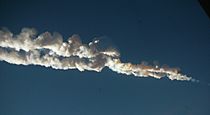Chelyabinsk meteor facts for kids
The Chelyabinsk meteor was a space rock that entered Earth's atmosphere on 15 February 2013. It happened over the city of Chelyabinsk in Russia, near the Ural Mountains. The event took place around 9:13 a.m. local time.
Contents
What Was the Chelyabinsk Meteor?
This space rock was moving incredibly fast, about 18 kilometers per second (40,000 miles per hour). It flew over the southern Ural region and then exploded high in the air. This explosion, called an "air burst," happened about 15 to 25 kilometers (10 to 15 miles) above the ground.
The energy released by the explosion was huge. It was like almost 500 kilotons of TNT, which is 20 to 30 times more powerful than the atomic bombs used in World War II. Scientists did not see this meteor coming because it was smaller than the objects they usually track.
Impact and Effects
Even though the meteor exploded high up, it caused a lot of damage on the ground. About 1,500 people were hurt, mostly by glass from windows that shattered. The powerful shock wave from the explosion broke windows in thousands of buildings.
The meteor created a super bright flash of light. It was so bright that it cast shadows in Chelyabinsk even during the daytime. People as far away as Kazakhstan could see it. Some eyewitnesses also felt intense heat from the fireball as it streaked across the sky.
A Rare Event
The Chelyabinsk meteor was the largest object to enter Earth's atmosphere since the 1908 Tunguska event. It is also the only known event of its kind to cause so many injuries. Luckily, no one died from the meteor.
Was It Connected to Another Asteroid?
On the same day, about 15 hours later, a much larger asteroid named 2012 DA14 passed very close to Earth. Some people wondered if the two events were connected. However, space agencies like NASA and the European Space Agency confirmed they were not. They had different paths in space, meaning they were just a coincidence.
Images for kids
-
Comparison of possible sizes of the Chelyabinsk (CM mark) and Tunguska meteoroids to the Eiffel Tower and the Empire State Building.
-
Illustrating all "phases", from atmospheric entry to explosion.
-
A full view of the smoke trail with the bulbous section corresponding to a mushroom cloud's cap.
See also
 In Spanish: Bólido de Cheliábinsk para niños
In Spanish: Bólido de Cheliábinsk para niños












